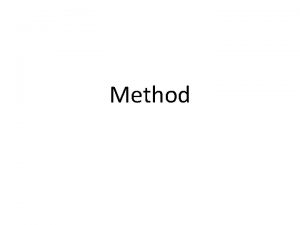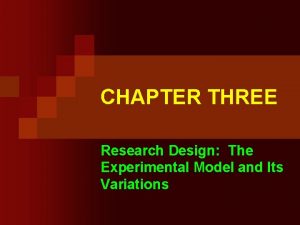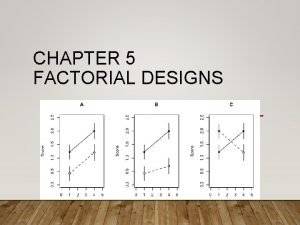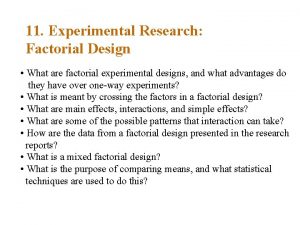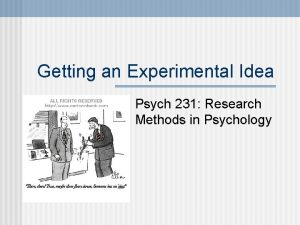Experimental Design Factorial Psych 231 Research Methods in

















- Slides: 17

Experimental Design: Factorial Psych 231: Research Methods in Psychology

Exam 2 coming up soon (1 week from today) n In labs: n Piloting your group projects n First draft of class experiment project due this week n Announcements

n Two or more factors n n Factors - independent variables Levels - the levels of your independent variables • 2 x 4 design means two independent variables, one with 2 levels and one with 4 levels • “condition” or “groups” is calculated by multiplying the levels, so a 2 x 4 design has 8 different conditions A 1 B 2 B 3 B 4 A 2 Factorial experiments

n Two or more factors (cont. ) n n Main effects - the effects of your independent variables ignoring (collapsed across) the other independent variables Interaction effects - how your independent variables affect each other • Example: 2 x 2 design, factors A and B • Interaction: • At A 1, B 1 is bigger than B 2 • At A 2, B 1 and B 2 don’t differ Everyday interaction = “it depends on …” Factorial experiments

n Rate how much you would want to see a new movie (1 no interest, 5 high interest) n Ask men and women Not much of a difference Interaction effects

n Suppose that George Clooney might star. You rate the preference if he were to star and if he were not to star. Effect of gender depends on who stars in the movie Interaction effects

n There are lots of different potential outcomes: • A = main effect of factor A • B = main effect of factor B • AB = interaction of A and B • With 2 factors there are 8 basic possible patterns of results: 1) No effects at all 2) A only 3) B only 4) AB only Results 5) A & B 6) A & AB 7) B & AB 8) A & B & AB

A 1 B 2 A 2 Condition mean A 1 B 1 A 2 B 1 Condition mean A 1 B 2 A 2 B 2 A 1 mean A 2 mean Main effect of A Interaction of AB What’s the effect of A at B 1? What’s the effect of A at B 2? B 1 mean B 2 mean Marginal means 2 x 2 factorial design Main effect of B

A 1 A 2 Main Effect of B B 1 30 60 45 B 2 30 60 B 45 Dependent Variable A Main Effect of A Main effect of B Interaction of A x B B 1 B 2 A 1 A √ X X Examples of outcomes

B 1 A 2 Main Effect of B 60 60 60 B B 2 30 30 45 45 30 Dependent Variable A Main Effect of A B 1 B 2 A 1 A Main effect of A X Main effect of B √ Interaction of A x B X Examples of outcomes

B 1 A 2 Main Effect of B 60 30 45 30 60 45 45 B B 2 45 Dependent Variable A Main Effect of A B 1 B 2 A 1 A Main effect of A X Main effect of B X Interaction of A x B √ Examples of outcomes

B 1 A 2 Main Effect of B 30 60 45 30 30 30 45 B B 2 30 Dependent Variable A Main Effect of A Main effect of B Interaction of A x B B 1 B 2 A 1 A √ √ √ Examples of outcomes

Let’s add another variable: test difficulty. test performance easy medium hard low mod anxiety high Test difficulty anxiety hard medium easy low mod high 35 80 35 65 80 80 80 60 main effect of anxiety Interaction ? Yes: effect of anxiety depends on level of test difficulty Anxiety and Test Performance main effect of difficulty 50 70 80

n Advantages n Interaction effects – Always consider the interaction effects before trying to interpret the main effects – Adding factors decreases the variability – Because you’re controlling more of the variables that influence the dependent variable – This increases the statistical Power of the statistical tests – Increases generalizability of the results – Because you have a situation closer to the real world (where all sorts of variables are interacting) Factorial Designs

n Disadvantages n n n Experiments become very large, and unwieldy The statistical analyses get much more complex Interpretation of the results can get hard • In particular for higher-order interactions • Higher-order interactions (when you have more than two interactions, e. g. , ABC). Factorial Designs

n You need to describe: n n n How many factors How many levels of each factor Whether the factors are within or between groups • e. g. , 2 (read by/to) x 2 (alphabetical/categorical ) completely between groups factorial design To By Alphabet 7. 9 8. 6 Categor y 9. 3 10. 5 Describing your design

• Main effect of both variables • No interaction Class experiment results
 Disadvantages of experimental research
Disadvantages of experimental research Experimental vs nonexperimental
Experimental vs nonexperimental Disinhibition
Disinhibition Research paradigm example
Research paradigm example Research instrument in experimental research
Research instrument in experimental research Experimental vs non experimental
Experimental vs non experimental Experimental vs non experimental
Experimental vs non experimental Nonexperimental study
Nonexperimental study Crossover design slideshare
Crossover design slideshare Non experimental research topics
Non experimental research topics Quasi experiment advantages and disadvantages
Quasi experiment advantages and disadvantages Non experimental correlational design
Non experimental correlational design Experimental research design
Experimental research design Experimental research design types
Experimental research design types Classic experimental design
Classic experimental design Experimental research design types
Experimental research design types Research design meaning
Research design meaning Between subjects factorial design
Between subjects factorial design




